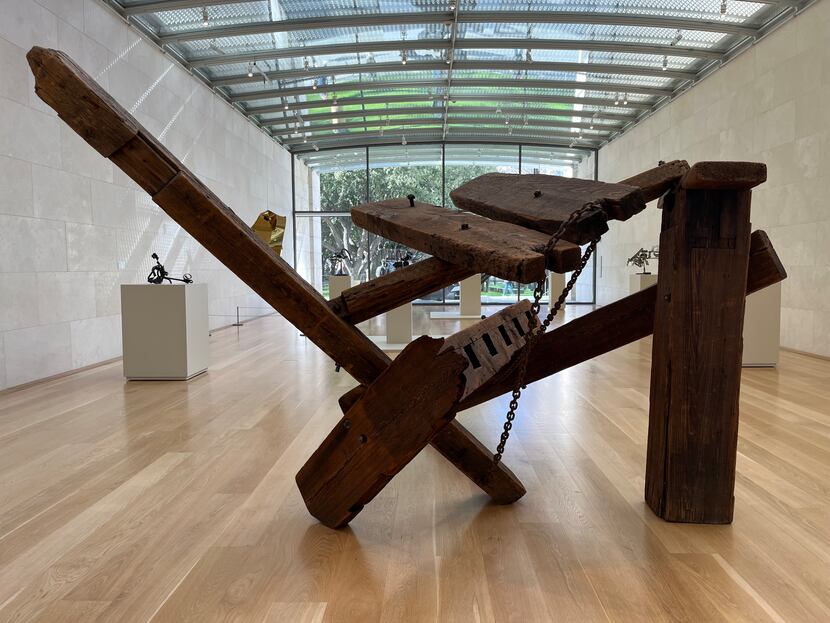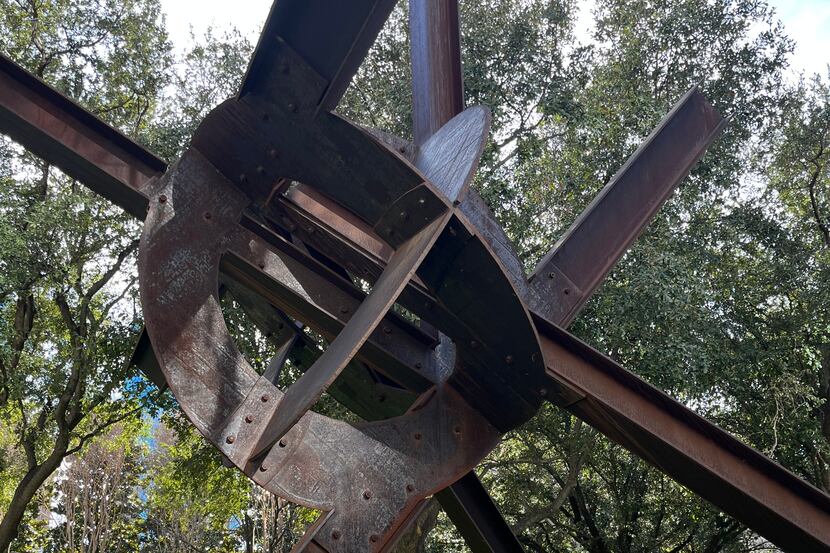The big steel sculptures of Mark di Suvero are such public presences in so many places that it can be easy to overlook them as super-size decor accessories. The gigantic red Ad Astra, towering through two levels of NorthPark Center, is surely one of the most often seen artworks in North Texas. The artist’s sprawling Ave hails visitors to the south entrance of the Dallas Museum of Art. In the Nasher Sculpture Center garden his Eviva Amore stretches arms and legs from an implied globe of intersecting circles.
Di Suvero was an early enthusiasm of the late Raymond and Patsy Nasher, who endowed the sculpture center bearing their name. Ray was also the enlightened developer of NorthPark, the rare shopping center that can be called architecturally distinguished, its interiors generously accessorized with modern sculptures.
Celebrating its 20th anniversary, and months before the artist’s 90th birthday, the Nasher is presenting the first major museum exhibition of di Suvero’s work in more than 30 years. For an artist so much associated with gigantic I-beam creations, di Suvero here is revealed as no less a master of intimacies. Small-scale sculptures have a gnarly playfulness, some even balanced for spinning. Works on paper — many, but not all, studies for sculptures — are astonishingly beautiful. The show was coordinated by Jed Morse, the Nasher’s chief curator.
If much modern art has been meant to challenge, even shock, a parallel force can be called populist modernism. The label fits di Suvero, whose longstanding commitment to peace and social justice got him arrested for anti-war protests and prompted a self-imposed European exile during the Vietnam War. For all their industrial abstraction, not to mention enormous weight, even the largest works exude a humane force field. Swing, in the Nasher’s entrance gallery, even invites you to recline in its rubber hammock.
Di Suvero was born in Shanghai to Italian parents who moved to San Francisco when he was 8. He earned a philosophy degree from the University of California at Berkeley but was increasingly drawn to sculpture. Moving to New York in 1957, he worked construction and other jobs to support his sculptural experiments, often assembled from heavy wooden beams and steel bits salvaged from building demolitions. His first solo exhibition, in 1960, attracted considerable notice.
A few months earlier, he was badly injured in an elevator accident at a construction site. Told he would never walk again, within two years he learned to maneuver with braces and crutches. He also learned to control the big cranes needed to bolt and weld the large steel sculptures with which he was increasingly identified.
It’s easy to see antecedents to di Suvero’s work in an adjacent Nasher gallery: totemic creations of David Smith, a small sculptural abstraction by Julio González, John Chamberlain’s assemblage of mangled auto body parts. Di Suvero’s splayed I-beams can also be seen as upended three-dimensional realizations of Franz Kline’s streaks of black paint on white.

In works both great and small, there’s tension between forces spreading and centering. Representing di Suvero’s early essays in rough-hewn wooden beams, iron bolts and chains is the sprawling Hankchampion. I don’t know what the St. John the Baptist title has to do with a 1961 concatenation of curved, punctured steel fragments and bent heavy grilles, painted black except for a streak of red, but it’s a dynamic composition.
Some of the smaller works are dialogues between contrasting materials and finishes, as with K-Orkd’s gnarly oxidized steel spinner pivoted on a base of scored stainless steel. (To protect the metals, this is a do-not-touch show, but if you’re lucky a gloved Nasher staffer may be on hand to demonstrate a spinning piece or two.)
Outside, even the 8-foot-tall For W.B. Yeats, an elaborate construct of Cor-Ten steel cuttings, is designed to spin, although it’s heavy enough to require some force to perform its stately pirouette. The title presumably alludes to Yeats’ poem “Among School Children,” with its final question: “How can we know the dancer from the dance?”
In addition to the small-scale sculptures, the Nasher show’s greatest revelations are the drawings and paintings mainly displayed downstairs. Boldly gestural, done in ink and marker, these often toy with geometries to be realized in three dimensions. Others, suggesting Chinese calligraphy, seem purely abstract, purely for visual pleasure. While best known for monumental works in steel, di Suvero can wield a brush or marker with gestural precision — indeed, eloquence.

Details
“Mark di Suvero: Steel Like Paper” runs through Aug. 27 at the Nasher Sculpture Center, 2001 Flora St. 214-242-5100, nashersculpturecenter.org.

